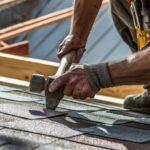Hail Resistance
SITUATION
Severe hailstorms damage and destroy thousands of roofs each year. This occurs at great expense and aggravation to property owners and insurance companies.
ANALYSIS
Property owners in areas prone to severe hail have done careful research to find hail-resistant materials. Additionally, insurance companies in certain areas are offering premium discounts to property owners who choose hail resistant roofing. Underwriters Laboratory has developed the UL 2218 test to measure the Impact Resistance of various roofing materials. This four-stage test calls for a 2” steel ball to be dropped onto the roofing sample from a height of 20 feet at its most severe stage. In order to pass the test, the roofing cannot crack or rupture. This test is performed on new roofing materials and does not take into consideration that some products become more brittle and less resistant to impact as they age.
SOLUTION
Many metal roof systems, including those produced by Classic Products, have passed the UL2218 standard at its most severe level — Class IV. Because metal, particularly aluminum, cannot lose impact resistance as it ages, homeowners who choose it are ensured of hail resistance for the life of their roof. Some manufacturers of metal roofing, including Classic Products, warrant against loss of impact resistance as well as against leakage due to hail perforation. This is very beneficial because, after a severe hailstorm, property owners might have to wait several weeks or months for a roofing contractor and they appreciate it when, with metal roofing, they are not dealing with roof leaks during that period. Severe hail can cause indentations to metal roofing. Although it varies between various roof designs, there is little or no damage visible to most metal roof systems after hail measuring up to golf ball size in diameter. Some formed metal shingles, shakes, and tiles have available foam backers for additional hail resistance. In all, metal offers a very wise roofing choice in all climates including those that are prone to severe hail.
